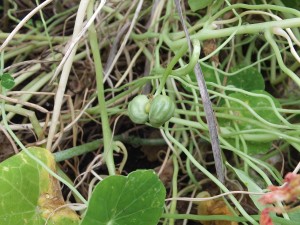 Without a greenhouse you can easily produce a near miraculous wonder crop. Indian cress grows luxuriantly from late spring till the autumn frosts almost anywhere, however under cover you will enjoy it for much much longer and without the weather damaging the flowers or pretty foliage. If this were a new discovery you would be amazed as this plant has almost every virtue you could wish for.
Without a greenhouse you can easily produce a near miraculous wonder crop. Indian cress grows luxuriantly from late spring till the autumn frosts almost anywhere, however under cover you will enjoy it for much much longer and without the weather damaging the flowers or pretty foliage. If this were a new discovery you would be amazed as this plant has almost every virtue you could wish for.
Firstly it is stunningly easy to grow, in any soil or compost, in under-sized pots, in cracks in the flooring, in dry arid corners, indeed anywhere other than in dense shade. You simply sow Indian cress and walk away with nothing other than occasional watering, it needs no feeding and seldom any pest control. It sometimes attracts cabbage white butterflies and of course slugs and snails. Effectively though Indian Cress is usually completely trouble free. You can harvest some as and when needed or just leave it to fill a border, bench or wall with colour while it quietly makes a useful seed crop.
The leaves are tasty in salads much resembling watercress and apparently are nearly as nutritious. These are produced continuously on trailing stems so young tender ones are always available. These stems can be trained up strings or canes to cover a wall or they can just be left to ramble. From early in the summer these long stems of leaves throw masses of large flowers along their length in a range of vibrant reds, yellows and orange. These spectacular flowers have a light sweet perfume and even more incredibly are also edible, and add cheerful colour to any salad. The flowers come all through the season and each is followed by a cluster of, yes edible, pea like seeds, which are much liked by both myself and my hens.
 These seeds are picked while still green, washed and brined then pickled in vinegar with bay leaf. An epicurean delight in the manner of capers these add a delicious zing to salads, sauces and pizzas.
These seeds are picked while still green, washed and brined then pickled in vinegar with bay leaf. An epicurean delight in the manner of capers these add a delicious zing to salads, sauces and pizzas.
By now you must have recognised Indian Cress is an old name for annual Nasturtiums, Tropaeolum majus (and the smaller minus). Brought from the New World this was once a sensation but has become so common-place we don’t take notice of it. Just because Indian Cress can be grown by children does not mean we should over-look this multi-facetted esculent plant. After all a collection of tub grown varieties trained up canes can be stunning- while remarkably cheap and easy to produce.
And if all that was not enough there are related species to collect such as T. peregrinum, the Canary Creeper, which covers itself with bright yellow blooms and the difficult but spectacular T. speciosum, Flame Flower. A peculiar relation is T. tuberosum, this is squatter, a bit duller and more potato like in habit, with edible roots rather resembling Jerusalem artichokes. Their texture and flavour, after various modes of preparation, are much appreciated in South America -but have seldom proved popular here in Europe other than as curiosities.


